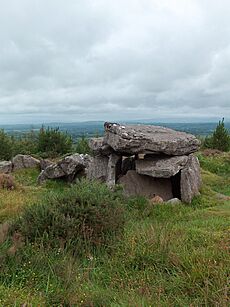Galbally, County Limerick facts for kids
Quick facts for kids
Galbally
An Gallbhaile (Irish)
|
|
|---|---|
|
Village
|
|

View looking south from the village square
|
|
| Country | Ireland |
| Province | Munster |
| County | County Limerick |
| Elevation | 112 m (367 ft) |
| Population
(2022)
|
269 |
| Irish Grid Reference | R798278 |
Galbally (which means "town of the stranger or the foreigner" in Irish) is a small village in the southeast part of County Limerick, Ireland. It sits right on the border with County Tipperary.
The village is located at the bottom of the beautiful Galtee Mountains. It is also at the western entrance to the Glen of Aherlow. The Aherlow River flows past the village from the mountains. This river later joins the Suir River near Cahir. Galbally is nestled in a valley, surrounded by the Galtee Mountains.
Contents
History of Galbally
Galbally has a long and interesting history. Many old sites and buildings in the area are protected. These places help us learn about the past.
Ancient Tombs and Legends
One important site is "Darby's Bed." This is a very old passage tomb, which is a type of burial chamber made from large stones. It sits on a hill nearby in a place called Duntryleague.
Irish legends say that "Darby's Bed" was one of the places where the famous characters Diarmuid and Grainne spent a night. They were hiding from the angry warrior Fionn MacCumhaill.
Moor Abbey: A Historic Friary

Just outside the village, you can find Moor Abbey. This was a Franciscan friary, which is a type of monastery where monks lived. It was started in the 1200s by Donach Cairbreach Ua'Briain.
The only part of the friary still standing today is its church, which was built in 1471. Moor Abbey had a difficult history. It was used until 1748, but there were times when no one lived there. Inside the church, you can still see parts of a tomb. It might be the tomb of the person who founded the friary.
Galbally Village Square
In the middle of Galbally's village square, there is a statue of a soldier. This statue remembers local volunteers who died during the War of Independence in 1921. This war was a fight for Ireland's independence.
The south side of the square used to be the site of a "poor house." This was a place for people who needed help during tough times, like the Great Irish Famine. Also, Charles Bianconi's horse-drawn carriages used to travel through Galbally. The stables they used are still standing on the north side of the village square.
Old Families and Estates
The Massy family, who were important English landowners, lived in the Duntryleague area. Their old burial place is still there. They settled in Galbally after receiving land in the 1600s. They were a powerful family in Ireland for a long time. Their summer home, Massy Lodge, is near the village of Anglesborough.
Also at Duntryleague, you can see the remains of an old Protestant church tower and a graveyard. Many members of the Bennett family are buried there. The Bennetts owned a large estate called Gleneffy House. The current Gleneffy House was built in the 1850s. It stands on the site of an older castle and is now a private home.
Village Life and Services
Galbally has many useful places and services for its residents and visitors. You can find several pubs, shops, and a chipper (a place that sells chips and other takeaway food). There are also bed and breakfasts (B&Bs) if you want to stay overnight.
The village has a carpenter's shop and an undertaker's. There is also a village museum and gallery, and an equestrian centre for horse riding. For sports, Galbally has pitches for field sports, a community field, and "all-weather" astro-turf facilities.
The local Catholic church is called the Church of Christ the King. It is part of the Galbally & Lisvernane parish, which crosses the border into County Tipperary. Lisvernane is the "sister" village in this parish.
Community and Sports Clubs
Galbally is a very active community, especially when it comes to sports!
Gaelic Games
The Gaelic Athletic Association (GAA) usually has one club in each parish. However, in Galbally's parish, there are two: Galbally on the Limerick side, and Aherlow on the Tipperary side.
While both clubs play some hurling, gaelic football is their main sport. Both clubs have won their county's senior football championships. Aherlow won the Tipperary title in 2006. Galbally won the Limerick Senior Football Championship for the first time in 1994 and again in 1997. Galbally also won the County Junior B Hurling title in 1995. The team was captained by John Kiely, who later became a very successful manager for the Limerick county hurling team, leading them to win the 2018 All-Ireland Senior Hurling Championship Final.
Other Sports and Community
The Galbally Camogie Club has teams for girls and women, from under 12s all the way up to senior level. Galbally is also home to the Mooreabbey Milers AC running club, for people who love to run.
In 1994, Galbally was chosen as the 'prettiest town in Ireland' in the yearly Irish Tidy Towns Competition. The village has won the Limerick competition nine times, showing how much the community cares about its appearance.
See also
 In Spanish: Galbally para niños
In Spanish: Galbally para niños



